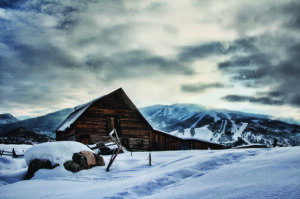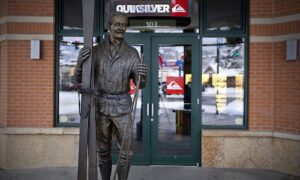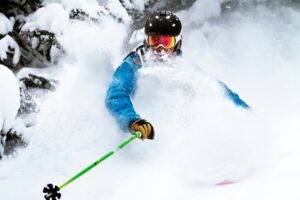Why We’re Called Steamboat

The Famous Steamboat Barn, the More Barn, was made famous by a 1970’s marketing poster of two riders on horseback with skis, going through 18 inches of fresh snow. It is a local icon and has been preserved as a historic building.
Steamboat is the northwesternmost resort in Colorado. For centuries it attracted Ute and Arapahoe tribes and European explorers and trappers. In the 1800s, a trio of French fur trappers were passing through town when they heard a strange chugging sound. The noise in question was not coming from a steamboat engine, but a bubbling spring. In 1908, train tracks were built over the site of the spring, which silenced the sound, but the town had already earned its name.
In 1874, a pioneer from Sedalia, Missouri named James H. Crawford first passed through the Yampa Valley and quickly returned a year later with his family to stake their claim on the land.
When the Crawford family approached the Yampa Valley for the first time together in 1875, 13-year-old Lulie wrote in her diary: “Ma gripped her hand over his (James) that held the reins and they just sat there in silence, looking. The valley was broad, sloping up to gentle hills and shouldered about by tall mountains. Fingers of meadowland reached back into purple gulfs of obscurity. The river, reflecting the glow from the sky, was a wide golden road dividing the dusk. Yonder to the left, myriads of tiny pools nestled in the shadows like bright fallen clouds. From the tall grass rose the quacking of wild ducks settling for the night. ‘Ours,’ Pa said in an awesome voice.”
By the mid-1880s, the town had a sawmill and development began. In 1885, the Steamboat Springs Town Company was formed and before long a general store, hotel, drugstore, bank, church and school popped up.
The Steamboat Pilot was established as the first newspaper and a bathhouse was constructed over one of the springs, supplying towels and soap for a small charge. A general store and hotel followed, along with a drugstore, bank, church and school. Winters were harsh, and transport in and out of Steamboat was almost nonexistent. The turn of the century brought great change; Steamboat Springs was incorporated in 1900 and James H. Crawford was elected major. A railroad was completed in 1908 and by 1913, more cattle was shipped from Steamboat than any other single point in the country. Strawberry, lettuce and hay production were prolific.
Ski Town USA®

A lifesize statue of Carl Howelsen, the Norwegian-born skier who brought ski jumping to Steamboat Springs, stands in front Howelsen Place in downtown Steamboat. Local artist Barbara Bouquet Robison created the bronze sculpture. Howelsen is known as the father of recreational skiing in Colorado.
Steamboat prospered as a hub for agriculture and mining, but in 1912 things would change. That’s when Carl Howelsen, a stonemason from Norway came to town, bringing his passion for skiing and ski jumping. Hailed the ‘Flying Norseman’ during a stint with the Barnum and Bailey Circus, he transformed skiing from winter necessity to sport. He would frequently be seen flying off a wooden platform in Strawberry Park before an animated audience. In 1914, Howelsen and his dear friend Charlotte Perry staged the first Steamboat Springs Winter Carnival. A year later the Steamboat Springs Winter Sports Club was formed. Over a century later, the carnival remains as the main fundraising event for the Steamboat Springs Winter Sports Club and a highlight on the town’s calendar of events. A permanent jump was built on Elk River Pasture and the site was renamed Howelsen Hill.
Ski jumping, Nordic, and Alpine skiing became popular on Howelsen Hill. By 1934, the hill had its first tow. In 1963, a second ski area opened with one double chair lift and a cabin, which served as a warming hut. The following year it was named Mount Werner after the towns’ Olympic hero, Buddy Werner, who was killed in an avalanche.
Over a century later, the Steamboat Springs Winter Sports Club has produced 96 winter Olympians and Howelsen Hill is the oldest, continuously running ski area in North America. The winter carnival remains a highlight on the community calendar every February. Galloping horses pull kids on skis or daredevils on shovels, down a snow-covered main street. Events like the Diamond Hitch Parade are a highlight of the celebrations, especially when the Steamboat Springs High School Marching Band comes through on skis. A night extravaganza and the legendary Lighted Man bring everyone together, beneath a firework-filled ski.
Steamboat’s international reputation as a skiing destination started across town on January 12, 1963. Storm Mountain opened with a double chair lift and an A-frame warming hut. In 1965 it was renamed Mount Werner in honor of Buddy Werner, a hometown Olympian who died the year before in an avalanche in Switzerland. Today the ski area boasts 18 lifts and 169 trails. Steamboat has hosted the 2010 U.S. Olympic Trials in freestyle and Nordic combined, the 2006 U.S. Olympic Trials in freestyle and the 2002 Gold Cup in Nordic combined.
Champagne Powder®

According to legend, a local rancher coined the term “champagne powder” in the 1950’s because the snow tickled his nose just like the bubbles in champagne. Champagne Powder® is light, dry, and smooth snow, which many skiiers regard as the best for skiing.
Like many of the legends behind the nicknames found in Steamboat, the term Champagne Powder® was coined by a local. In the 1950s, rancher Joe McElroy was skiing with a few buddies. He thought the light snow resembled bubbles in champagne, a Steamboat-centric anomaly. The snow in Routt County has a lot more air in it and averages 6 percent water content, which is almost half of nearly all other ski destinations.
Steamboat Today
Steamboat became known as Ski Town U.S.A. and it has produced more winter Olympians than any other town in the nation. Agriculture remains a lifeline for much of the town and its presence is celebrated year round at parades and events. Although the sound of chugging from the one thermal spring can no longer be heard, people continue to flock to Steamboat to soak in several of the 150 reported mineral springs in the valley.
In 1881, Colorow, a Ute Indian leader put a “curse” on the Yampa Valley. Legend has it that Colorow declared: “Those who come to the Yampa Valley to live will never be able to leave. If they do succeed in leaving the valley, they’ll be forced to return.” Natural beauty, rich heritage and community feel continue to lure people and keep them here, calling Steamboat home, just as the Crawfords would have hoped.